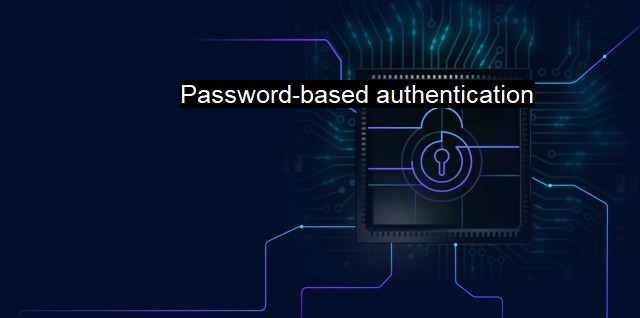What is Password-based authentication?
The Importance of Strong Password-Based Authentication in Cybersecurity and Antivirus Systems: Risks, Challenges, and Solutions
Password-based authentication stands as one of the most common ways to protect access to systems and data. Requiring a user to provide a private piece of information before gaining access, this method has been a long-standing cornerstone of security and privacy methods for years.To understand the significance of password-based authentication, you need to first understand the concept of authentication. In simplest terms, authentication is the process of verifying the identity of a user or a system. This ensures that a personalized environment can be established for a secure online experience. proper authentication ensures that sensitive information like credit card numbers, social security numbers, residential addresses, etc., are not shared or accessed by anyone unprivileged or unauthorized.
Password-based authentication is just one modality of this principle, with others including biometric, token, and multi-factor authentication. It remains widely used due to its simplicity and effectiveness. Individual users create an exclusive password, and this becomes the key to their system or account. With sound password creation and management practices, this modality can offer adequate levels of security for the majority of users.
As internet applications and digital platforms increase worldwide, the consequences of weak password practices have become more severe. it is common knowledge that human error is often the weakest link. Hence, when a hacker tries to access a system, they might begin by attempting to compromise the password. As such, poorly crafted, predictable, or reused passwords present highly exploitable vulnerabilities. Therefore, it is imperative to foster strong password hygiene to deny hackers this easy route into personal systems and data.
Specific guidelines to establish strong password practices include creating passwords with at least eight characters, including upper-case and lower-case letters, numbers, and special characters. Many experts recommend changing passwords every three to six months. Also, it is advisable never to reuse the same password across multiple accounts, as compromising this single password could lead to what is known as a 'domino effect', leading unknowingly to multiple account breaches.
Despite these guidelines, as per various insights and researches, people still choose convenience over complex passwords. Therefore, a lot of organizations promote two-factor or multi-factor authentication, combining password-based authentication with other methods, like fingerprint biometrics or unique security codes sent to a known mobile phone.
In the antivirus context, password-based authentication is equally important. Antivirus software uses passwords to protect its configurations, access cybersecurity settings, and, in some cases, to encrypt data. Passwords protect the antivirus software from unauthorized adjustments which could tamper with its effectiveness or potentially disable it.
Given the rise of sophisticated cyber threats, it is crucial that password-based authentication continues to advance alongside. Techniques like hashing and salting enhance password-based authentication by storing credentials in an unreadable format, rendering stolen information useless to hackers. a tactic like password throttling, which involves limiting attempted logins, makes brute force and dictionary attacks untenable.
The primary limitation of password-based authentication is its vulnerability to human factors. This method's effectiveness is left to the responsibility of users who possess discrepant views and crafts on password appending. As long as this challenge exists, so will the corresponding potential for cyber breach.
In sum, password-based authentication remains a central figure keeping unauthorized parties at bay and preserving the integrity of personal and business data. As cyber-threats continue to evolve, so must our password creation and management habits. It is important to leverage advances in this area to maintain an effective safeguard against intrusion attempts. while password-based authentication is a potent tool, combining it with other authentication methods will always offer a more secure environment, ensuring that decryption of sensitive information remains a challenging, if not impossible, task for unauthorized entities.

Password-based authentication FAQs
What is password-based authentication?
Password-based authentication is a security mechanism that requires the user to enter a password to verify their identity before granting them access to a system or application. It is one of the most common methods of authentication used in cybersecurity.Why is password-based authentication considered insecure?
Password-based authentication is considered insecure because passwords can be easily guessed or stolen. Users often choose weak or common passwords that attackers can easily crack using brute-force or dictionary attacks. Passwords can also be compromised through phishing attacks or by malicious software like viruses and Trojans.What are some best practices for password-based authentication?
Some best practices for password-based authentication are to use strong and unique passwords, never share passwords with others, and regularly change passwords. It is also recommended to use multi-factor authentication, where the user must provide more than one form of identification, such as a password and a fingerprint or a code sent to their phone.How can antivirus software help with password-based authentication?
Antivirus software can help with password-based authentication by detecting and blocking malware that may be stealing passwords or attempting to guess them. Some antivirus programs also offer password managers that can generate and securely store strong passwords for the user. However, antivirus software alone cannot guarantee the security of password-based authentication; it is important for users to follow best practices and use additional security measures like multi-factor authentication.| | A | | | B | | | C | | | D | | | E | | | F | | | G | | | H | | | I | | | J | | | K | | | L | | | M | |
| | N | | | O | | | P | | | Q | | | R | | | S | | | T | | | U | | | V | | | W | | | X | | | Y | | | Z | |
| | 1 | | | 2 | | | 3 | | | 4 | | | 7 | | | 8 | | |||||||